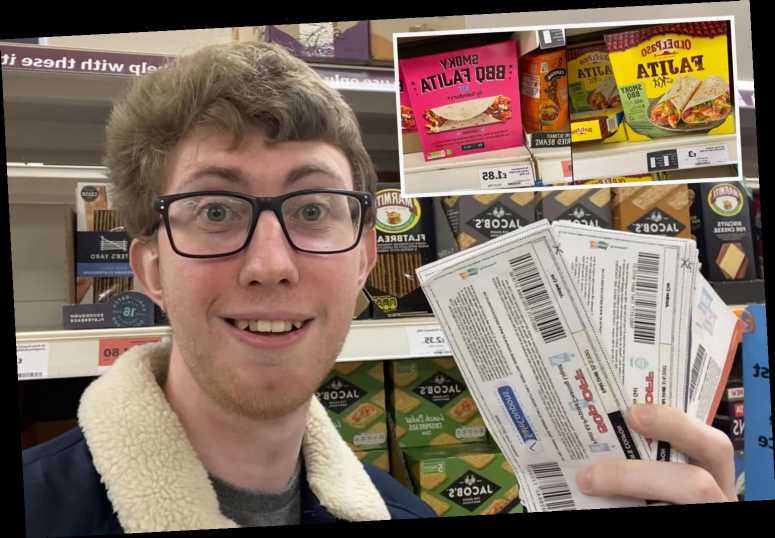
Thrifty shopper shares supermarket hacks so YOU can save on your shop – from ‘downshifting’ to ignoring multi-packs
02/16/2021A THRIFTY shopper has revealed his supermarket secrets and the hacks he uses to reduce his food shop.
While supermarket shopping is essential, Jordon Cox, 22, says there are ways to avoid the 'tricks' grocery giants use to get customers to spend more.
"Most people spend more time in supermarkets than any other shop – but over the years the grocery giants have mastered the tricks to getting customers to spend more," he told NHS Discount Offers.
Once you know the tricks of the trade that supermarkets use to jump up the price of your basket, you can try to avoid them, and potentially save hundreds on your shopping.
From downshifting, to switching aisles and even shopping at the right time – here are some tips to cut down your supermarket shopping bill by £100s or even £1,000s each year:
1. Downshift your shopping
Jordon said 'Brits can be brand snobs' and that many people 'stick to what we know' rather than explore cheaper options.
He reckons you can be paying up to 70% extra by doing this and recommends 'downshifting' – the practice of'shifting down one brand level when shopping to see if you like a cheaper alternative.'
"This not only saves you money, but if you like or prefer the cheaper option, you’ll have a new go-to item, which can pile up the savings over time to the tune of £10s or £100s a year," he explained.
He also added that a lot of the name brands are made in the same factory and have the same ingredientsas cheaper ones – so there may not even be a difference, only the price.
2. Shop in the world foods aisle
In Jordon's opinion, this aisle is commonly overlooked, but there can be some bargains if you know what to look for.
Specific items such as Twinkies or Marshmallow Fluff while cost you a pretty penny, but items such as rice, sauces and spices can actually end up far cheaper.
He said: "When searching in my local Sainsbury’s, one of the best examples I found was a 100g bag of Natco Paprika Power for 80p.
"If you wanted a comparable jar from the spice aisle – the cheapest was Sainsbury’s own brand at 85p… but for 44g (less than half).
"The difference in price and size meant the world food item was 8p per 10g – and the cheapest spice aisle was 19.8p per 10g."
3. Complain if things go wrong
Jordon reckons if something's wrong you should definitely speak up -either tell the supermarket or the brand what the problem is.
He said: "It’s perfectly reasonable under the consumer rights act to ask for a refund on faulty goods – but more often than not, as a gesture of goodwill, supermarkets and brands send you coupons or gift cards for more than the item is worth."
4. Shop in the baby aisle (even if you don’t have a kid)
Because if the variety of items in most stores, Jordon said they may change the packaging and price to make it look like a different product, despite it being nearly identical.
He explained: "The best examples of this are in the baby aisle instead of the beauty aisle.
"If you were looking for some cosmetic cotton buds in the beauty aisle – you could pay nearly double the price of a pack of 200 baby cotton buds. When in fact – they are the same item with different packaging.
"Most supermarkets are guilty of this – and here’s an example online at Waitrose. If they look the same – it’s because they probably are. But you’re paying double for the same amount."
5. Look high and low on shelves
It's easy to look at what's straight in front of you, but Jordon said this is where supermarkets put the items they WANT you to buy – and they're often more expensive.
"They want your eyes to naturally gravitate to the shelf you’re eye level with, instead of gazing up and down looking for other items," he said.
Quite often you’ll find the best deals tucked away either down low, up high or the the corners of aisles – as these aren’t places shoppers tend to look the most.
6. Yellow sticker discounts
This is where you can get a lot of bargain food, Jordon said and while each supermarket put their sticker items out at different times it's worth shopping at this time.
He explained: "On the whole you can start to see discounts from 12pm, with the largest discounts (up to 90% off) at around an hour before closing time.
"You can usually find yellow sticker discounts in the chilled aisles and the bakery sections – but keep an eye out wherever you walk for the yellow glint."
7. Switching your medicine
When it comes to pills and medicine for pain relief, cold & flu or indigestion – there’s only one type you should be buying – supermarket own brands.
Jordon said that no matter what medicine it is, both the name brand and the supermarket own brands both have the same active ingredient most of the time.
He said: "You can check the ingredients on each pack, and as long as the active ingredient is the same – it’s totally fine and safe to buy the cheaper one."
The difference can be huge too. Buying the standard Ibuprofen instead of Nurofen can save you £1.50 per box – and both contain 200mg of ibuprofen with extra ingredients for the coating.
"A few different medicines also share the same ‘PL number’, which is given to a certain drug made by a certain company. Don’t be surprised if your Gaviscon shares the same PL number as a cheaper brand – and that’ll mean it’s the same medicine instead with ingredients exactly the same," he added.
8. 'Value Packs' aren’t always the best value
Just because a pack of something says ‘value pack’ or ’50% extra’ doesn’t make it the cheapest, according to the shopper.
"You do have to be beady-eyed in the supermarket, as prices change all the time," he said. "It’s not unusual that buying two smaller packs it cheaper and more cost effective than buying the larger ‘value packs’.
He suggests alwayschecking the 'price per 100ml/g' when you buy anything as this will tell you which one works out cheapest gram for gram.
9) Don’t be duped into 'Thins' Or 'Minis'
Jordon said this may be great for variety, but not great if you’re looking for the best value.
Specifically with biscuits and crackers – and falling for it can it cost you twice as much.
He said: "One example being Mcvities chocolate digestive biscuits. The ‘thins’ pack costs £1.59 for 180g – but the standard pack you can pick up for £1.35 and 266g in weight.
"The ‘thins’ pack is prices at 88p per 100g, while the usual pack is 51p per 100g – so there’s quite a big difference."
10. Bulk buy if there’s a good deal
Supermarket offers can be a great deal from time to time – and if you see one, there’s nothing to stop you buying more than one.
This is especially true for non perishables like toothpaste, toilet paper and shampoo. If you have room to store them.
"It makes sense that if you see a price on something that is low (and you’re likely to buy again in the coming weeks), then grab a few," he said.
"The last thing you want to do is buy something at full price (if you can help it), so the more you can buy at the cheapest price – the better."
We also revealed the supermarket secrets YOU need to know to save money and time – and why you should always weigh your veg.
For more money saving tips, we recently revealed the cheap flooring alternatives if you can’t afford new carpet – and how to make a ‘tiled’ floor with tester paint pots.
We also shared the best home transformations you can do for under £30, from hotel-inspired bathrooms to stunning kitchen makeovers.
Source: Read Full Article








